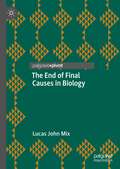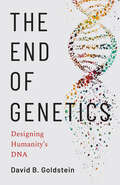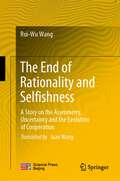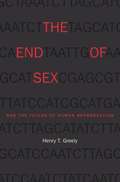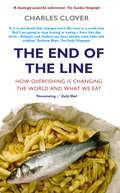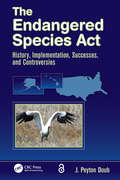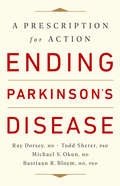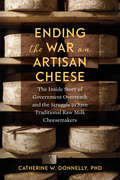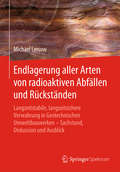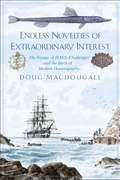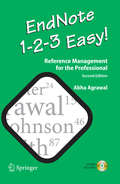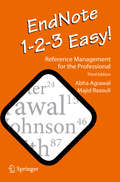- Table View
- List View
The End of Everything: (Astrophysically Speaking)
by Katie MackFrom one of the most dynamic rising stars in astrophysics, an eye-opening look at five ways the universe could end, and the mind-blowing lessons each scenario reveals about the most important ideas in cosmologyWe know the universe had a beginning. But what happens at the end of the story?With lively wit and wry humour, astrophysicist Katie Mack takes us on a mind-bending tour through each of the cosmos' possible finales: the Big Crunch, Heat Death, Vacuum Decay, the Big Rip and the Bounce. Guiding us through major concepts in quantum mechanics, cosmology, string theory and much more, she describes how small tweaks to our incomplete understanding of reality can result in starkly different futures. Our universe could collapse in upon itself, or rip itself apart, or even - in the next five minutes - succumb to an inescapable expanding bubble of doom.This captivating story of cosmic escapism examines a mesmerizing yet unfamiliar physics landscape while sharing the excitement a leading astrophysicist feels when thinking about the universe and our place in it. Amid stellar explosions and bouncing universes, Mack shows that even though we puny humans have no chance of changing how it all ends, we can at least begin to understand it.The End of Everything is a wildly fun, surprisingly upbeat ride to the farthest reaches of all that we know.
The End of Final Causes in Biology
by Lucas John MixThis book provides a straightforward introduction to teleology in biology, the work it did and the work it can do. Informed by history and philosophy, it focuses on scientific concerns. Seventeenth, eighteenth, and nineteenth century biologists proposed a menagerie of biological “actors” to explain power without appealing to Aristotelian vegetable souls and final causes. Three constraints on teleology narrowed the field, selecting among the various actors as they mutated and recombined. Methodological naturalism, local adaptation, and blind chance each represent a significant philosophical advance in biology. Kant, Darwin, and the Modern Synthesis provided a new teleology, grounded in natural selection, an etiological recursion of form and function, and the details of carbon chemistry on Earth. They naturalized teleology, but they also finalized nature, shifting conceptions about the world and science. Understanding these links – historical, philosophical, and theoretical – sets the stage for new work moving forward.
The End of Genetics: Designing Humanity's DNA
by David B. GoldsteinAn urgent plea for a broader understanding and awareness of the unconsidered dangers of new genetic technologies Since 2010 it has been possible to determine a person’s genetic makeup in a matter of days at an accessible cost for many millions of people. Along with this technological breakthrough there has emerged a movement to use this information to help prospective parents “eliminate preventable genetic disease.” As the prospect of systematically excluding the appearance of unwanted mutations in our children comes within reach, David B. Goldstein examines the possible consequences from these types of choices. Engaging and accessible, this clarion call for responsible and informed stewardship of the human genome provides an overview of what we do and do not know about human genetics and looks at some of the complex, yet largely unexplored, issues we must be most careful about as we move into an era of increasing numbers of parents exercising direct control over the genomes of their children.
The End of Rationality and Selfishness: A Story on the Asymmetry, Uncertainty and the Evolution of Cooperation
by Rui-Wu WangThis book reviews the antinomy of rationality and selfishness raised from egoism, though rationality and selfishness are understood as basic evolutionary dynamics of humans and other organisms in both classical economics and evolutionary biology. Based on the research and a comparison with human’s social cooperative behavior, the author presents his belief that the social cooperative system, in its essence, cooperation and conflict are of uncertain stochasticity resulting from their intrinsic asymmetric interaction between cooperative partners. The book then discusses limitations of Newton’s methodology of monism in both biology and social science. The understanding of the asymmetric and uncertain characteristics found in cooperation system needs perspective of quantum physics of pluralism. At the end of the book, the author undertakes a review of consistency of Newtonian and monism philosophy and the links between quantum physics and pluralism philosophy.
The End Of Science: Facing The Limits Of Knowledge In The Twilight Of The Scientific Age
by John HorganIn The End of Science, John Horgan makes the case that the era of truly profound scientific revelations about the universe and our place in it is over. Interviewing scientific luminaries such as Stephen Hawking, Francis Crick, and Richard Dawkins, he demonstrates that all the big questions that can be answered have been answered, as science bumps up against fundamental limits. The world cannot give us a "theory of everything,” and modern endeavors such as string theory are "ironic” and "theological” in nature, not scientific, because they are impossible to confirm. Horgan's argument was controversial in 1996, and it remains so today, still firing up debates in labs and on the internet, not least because-as Horgan details in a lengthy new introduction-ironic science is more prevalent than ever. Still, while Horgan offers his critique, grounded in the thinking of the world's leading researchers, he offers homage, too. If science is ending, he maintains, it is only because it has done its work so well.
The End of Sex and the Future of Human Reproduction
by Henry T. GreelyWithin twenty, maybe forty, years most people in developed countries will stop having sex for the purpose of reproduction. Instead, prospective parents will be told as much as they wish to know about the genetic makeup of dozens of embryos, and they will pick one or two for implantation, gestation, and birth. And it will be safe, lawful, and free. In this work of prophetic scholarship, Henry T. Greely explains the revolutionary biological technologies that make this future a seeming inevitability and sets out the deep ethical and legal challenges humanity faces as a result. “Readers looking for a more in-depth analysis of human genome modifications and reproductive technologies and their legal and ethical implications should strongly consider picking up Greely’s The End of Sex and the Future of Human Reproduction…[It has] the potential to empower readers to make informed decisions about the implementation of advancements in genetics technologies.” —Dov Greenbaum, Science “[Greely] provides an extraordinarily sophisticated analysis of the practical, political, legal, and ethical implications of the new world of human reproduction. His book is a model of highly informed, rigorous, thought-provoking speculation about an immensely important topic.” —Glenn C. Altschuler, Psychology Today
The End of Sex and the Future of Human Reproduction
by Henry T. GreelyWithin twenty, maybe forty, years most people in developed countries will stop having sex for the purpose of reproduction. Instead, prospective parents will be told as much as they wish to know about the genetic makeup of dozens of embryos, and they will pick one or two for implantation, gestation, and birth. And it will be safe, lawful, and free. In this work of prophetic scholarship, Henry T. Greely explains the revolutionary biological technologies that make this future a seeming inevitability and sets out the deep ethical and legal challenges humanity faces as a result. “Readers looking for a more in-depth analysis of human genome modifications and reproductive technologies and their legal and ethical implications should strongly consider picking up Greely’s The End of Sex and the Future of Human Reproduction…[It has] the potential to empower readers to make informed decisions about the implementation of advancements in genetics technologies.” —Dov Greenbaum, Science “[Greely] provides an extraordinarily sophisticated analysis of the practical, political, legal, and ethical implications of the new world of human reproduction. His book is a model of highly informed, rigorous, thought-provoking speculation about an immensely important topic.” —Glenn C. Altschuler, Psychology Today
The End Of The Line: How Overfishing Is Changing The World And What We Eat
by Charles CloverWe have reached a pivotal moment for fishing, with seventy-five percent of the world's fish stocks either fully exploited or overfished. If nothing is done to stop the squandering of fish stocks the life of the oceans will face collapse and millions of people could starve. Fish is the aspirational food for Western society, the healthy, weight-conscious choice, but those who eat and celebrate fish often ignore the fact that the fishing industry, although as technologically advanced as space travel, has an attitude to conservation 10,000 years out of date. Trawling on an industrial scale in the North Sea takes 16 lbs of dead marine animals to produce just 1lb of sole. Regulation isn't working, fishermen must cheat or lose money, dolphins and other wildlife (seabirds, turtles, sharks) are killed unnecessarily and fish stocks are collapsing despite the warnings. The End of the Line looks at the problem and proves that we, as consumers, have to change if the situation is to improve.
Endangered Animals: A Reference Guide to Conflicting Issues
by Brian Miller Richard P. ReadingExplore the multiple issues that surround species declines and conservation efforts through the only reference source to examine the conflicting conservation issues of 49 endangered species. While the causes of endangerment are relatively easy to understand, the ultimate or underlying factors are often far more complex and difficult to address. An introduction to these issues and how to resolve them is provided in this unique collection of case studies of animal species that have been pushed to the brink of extinction. Each case study provides the following information: - Common name - Scientific name - Order - Family - Status - Threats - Habitat - Distribution - Natural history - Conflicting Issues - Future and Prognosis.Conservationists are increasingly recognizing that the ultimate causes of extinction are primarily socio-economic and political, yet biological approaches to recovery continue to dominate. More inclusive, interdisciplinary conservation programs are explored here to offer better prospects for managing problems and conflicts. In addition to the case studies, trends and common themes are explored to provide a comprehensive, interdisciplinary approach to conservation. Students and teachers can explore a wide variety of endangered species programs and the conflicting issues common to recovery efforts, which will enable them to evaluate conservation practice and to draw their own conclusions for improvement.
The Endangered Species Act: History, Implementation, Successes, and Controversies
by J. Peyton DoubThe complex regulations of the Endangered Species Act can be challenging for environmental professionals who must comply with them or assist clients in compliance. This volume discusses the Act using clear scientific prose that all professionals can readily comprehend. It explores the history and the basic scientific theory underlying the Act. It provides an overview of its key provisions and examines the Act in the context of other key environmental planning statutes. The book also details the regulatory processes faced by other government agencies and private developers who must routinely ensure that their actions are in compliance.
The Endangered Species Act: History, Implementation, Successes, and Controversies
by J. Peyton DoubThe complex regulations of the Endangered Species Act can be challenging for environmental professionals who must comply with them or assist clients in compliance. This volume discusses the Act using clear scientific prose that all professionals can readily comprehend. It explores the history and the basic scientific theory underlying the Act. It provides an overview of its key provisions and examines the Act in the context of other key environmental planning statutes. The book also details the regulatory processes faced by other government agencies and private developers who must routinely ensure that their actions are in compliance.
Endangered Species and Fragile Ecosystems in the South China Sea: The Philippines v. China Arbitration
by Alfredo C. Robles, Jr.This book presents an in-depth analysis of the environmental issues raised in the South China Sea Arbitration Awards, which have not attracted as much attention in the Philippines as the “nine-dash line”. Specifically it focuses on the conservation of endangered species and the conservation of fragile ecosystems in the South China Sea. The aims of the book are two-fold. First, it seeks to explain the Philippine perspective on the environmental aspects of its dispute with China. The book reconstructs the Philippine perspective in part by consulting several dozens of the hundreds of documents that the Philippines submitted to the Tribunal. Some of these documents were classified as secret and would thus have never been made available to the public had it not been for the arbitration. Second, it attempts to explain the decisions of the Tribunal on jurisdiction and admissibility as well as the decisions on the merits of the dispute. The book does this by consulting not only the two Awards but also the hundreds of pages of transcripts, expert reports, supplemental submissions and written responses by the Philippines to questions posed by the Tribunal.
Endeavoring for China’s Environment and Development Transformation: Three Decades of China Council for International Cooperation on Environment and Development (CCICED)
by Yingmin Zhao Arthur HansonThis is an open access book. CCICED has been woven into the fabric of China’s environmental development for the past 30 years—the length of an entire generation. It is also consistent with the most rapid modernization shift of the nation’s economy–environment relationship. This report provides insights into how CCICED operates and its success stories. It also presents a general picture of how changes of China in environmental development have taken place. CCICED at 30 is therefore a helpful account for future directions of sustainable environment.
Endemism in Vascular Plants (Plant and Vegetation #9)
by Carsten HobohmThe book is the first comprehensive analysis of the macroecology and geobotany of endemic vascular plants with case-studies and analyses from different regions in the world. Endemism is a pre-extinction phenomenon. Endemics are threatened with extinction. Due to international nature conservation policies and due to the perception of the public the concept’s importance is increasing. Endemism can result from different biological and environmental processes. Depending on the process conservation measures should be adapted. Endemic vascular plant taxa, in the setting of their species composition and vegetation types are important features of landscapes and indicators of the quality of relating habitats. The book is an important basis for biologists, ecologists, geographers, planners and managers of nature reserves and national parks, and people generally interested in nature conservation and biogeography of vascular plants.
Ending Medicine’s Chronic Dysfunction: Tools and Standards for Medical Decision Making (Synthesis Lectures on Assistive, Rehabilitative, and Health-Preserving Technologies)
by Lawrence L. Weed Lincoln WeedThis book describes an overlooked solution to a long-standing problem in health care. The problem is an informational supply chain that is unnecessarily dependent on the minds of doctors for assembling patient data and medical knowledge in clinical decision making. That supply chain function is more than the human mind can deliver. Yet, dependence on the mind is built into the traditional role of doctors, who are educated and licensed to rely heavily on personal knowledge and judgment. The culture of medicine has long been in denial of this problem, even now that health information technology is increasingly used, and even as artificial intelligence (AI) tools are emerging. AI will play an important role, but it is not a solution. The solution instead begins with traditional software techniques designed to integrate novel functionality for clinical decision support and electronic health record (EHR) tools. That functionality implements high standards of care for managing health information. This book describes that functionality in some detail. This description is intended in part to be a starting point for developers in the open source software community, who have an opportunity to begin developing an integrated, cloud-based version of the tools described, working with interested clinicians, patients, and others. The tools grew out of work beginning more than six decades ago, when this book’s lead author (deceased) originated problem lists and structured notes in medical records. The electronic tools he later developed led him to reconceive education and licensure for doctors and other health professionals, which are also part of the solution this book describes.
Ending Parkinson's Disease: A Prescription for Action
by Michael S. Okun Ray Dorsey Todd Sherer Bastiaan R. BloemIn this "must-read" guide (Lonnie Ali), four leading doctors and advocates offer a bold action plan to prevent, care for, and treat Parkinson's disease-one of the great health challenges of our time. Brain diseases are now the world's leading source of disability. The fastest growing of these is Parkinson's: the number of impacted patients has doubled to more than six million over the last twenty-five years and is projected to double again by 2040. Harmful pesticides that increase the risk of Parkinson's continue to proliferate, many people remain undiagnosed and untreated, research funding stagnates, and the most effective treatment is now a half century old.In Ending Parkinson's Disease, four top experts provide a plan to help prevent Parkinson's, improve care and treatment, and end the silence associated with this devastating disease.
Ending the War on Artisan Cheese: The Inside Story of Government Overreach and the Struggle to Save Traditional Raw Milk Cheesemakers
by Doctor Catherine DonnellyA prominent food scientist defends the use of raw milk in traditional artisan cheesemaking. Raw milk cheese—cheese made from unpasteurized milk—is an expansive category that includes some of Europe’s most beloved traditional styles: Parmigiano Reggiano, Gruyère, and Comté, to name a few. In the United States, raw milk cheese forms the backbone of the resurgent artisan cheese industry, as consumers demand local, traditionally produced, and high-quality foods. Internationally award-winning artisan cheeses like Bayley Hazen Blue (Jasper Hill, VT) would have been unimaginable just forty years ago when American cheese meant Kraft Singles. Unfortunately the artisan cheese industry faces an existential regulatory threat. Over the past thirty years the US Food and Drug Administration (FDA) has edged toward an outright ban on raw milk cheeses. Their assault on traditional cheesemaking goes beyond a debate about raw milk safety; the FDA has also attempted to ban the use of wooden boards, the use of ash in cheese ripening, and has set stringent microbiological criteria that many artisan cheeses cannot meet. The David versus Goliath existence of small producers fighting crushing regulations is true in parts of Europe as well, where beloved creameries are going belly-up or being bought out because they can’t comply with EU health ordinances. Centuries-old cheese styles like Fourme d’Ambert and Cantal are nearing extinction, leading Prince Charles to decry the “bacteriological correctness” of European regulators. The dirty secret is that Listeria and other bacterial outbreaks occur in pasteurized cheeses more often than in raw milk cheeses, and traditional processes like ash-ripening have been proven safe. In Ending the War on Artisan Cheese, Dr. Catherine Donnelly forcefully defends traditional cheesemaking, while exposing government actions in the United States and abroad designed to take away food choice under the false guise of food safety. This book is fundamentally about where and how our food is produced, the values we place on methods of food production, and how the roles of tradition, heritage, and quality often conflict with advertising, politics, and profits in influencing our food choices.
Endlagerung aller Arten von radioaktiven Abfällen und Rückständen: Langzeitstabile, langzeitsichere Verwahrung in Geotechnischen Umweltbauwerken – Sachstand, Diskussion und Ausblick
by Michael LersowDieses Buch stellt alle Arten radioaktiver Abfälle und Rückstände gemäß der Klassifikation der IAEA vor, wie z.B. hochradioaktive Abfälle, Rückstände aus der Uranerzaufbereitung der SDAG Wismut, die Abfälle der Asse etc. Mit radiotoxischem Material assoziieren die meisten Menschen Gefahr für sich und die Umwelt, welche Abwehrmaßnahmen konkret getroffen werden wissen sie aber nicht.So wurden Multi-Barrieren- Endlagersysteme entwickelt, welche die eingelagerten Radionuklide zurückhalten und/oder Wegsamkeiten minimieren, so dass eine Ausbreitung in die Biosphäre massiv erschwert wird und auftretende Expositionen in den Zulässigkeitsgrenzen bleiben. Inventarangaben und ein Radiotoxizitätsindex im Buch erlauben dem Leser die Langzeitsicherheit nationaler und internationaler Endlagerbauwerke abzuschätzen und die jeweiligen Gefahrenlagen und die daraus resultierende technische und soziale Umweltüberwachung nachzuvollziehen. Wie ist ein Langzeitsicherheitsnachweis aufgebaut, welchen Einfluss hat der Nachweiszeitraum. Nachfolgende Generationen müssen Gefahrenzustände aus bestehenden Endlagerbauwerken abwehren können. Auf welche Erfahrungen und Ergebnisse der heutigen Generation dabei zurückgegriffen werden kann, ist in diesem Buch dargelegt.
Endless Forms Most Beautiful: The New Science of Evo Devo and the Making of the Animal Kingdom
by Sean B. CarrollWe not only share nearly 99% of our genes with chimps, we also have some 35% in common with daffodils. Throughout much of the animal and even plant kingdoms, almost the same ancient genes code for almost the same proteins. And further, to everyone's astonishment, the genes involved in making the complex eyes of fruitflies are close matches to those involved in making the very different eyes of octopuses and people. So what leads to the nature's 'endless forms most beautiful'? The key to this mystery is being unravelled by 'Evo Devo' or the new science of evolutionary development biology. By looking at how a single-celled egg gives rise to a complex, multi-billion celled animal, Evo Devo is illuminating exactly how new species - butterflies and zebras, trilobites and dinosaurs, apes and humans - are made and evolved. The key, it turns out, is all about location and timing... For anyone who has ever pondered 'where did I come from', Endless Forms Most Beautiful explores our history, both the journey we have all made from egg to adult, and the long trek from the origin of life to the very recent origin of our species.
Endless Novelties of Extraordinary Interest: The Voyage of H.M.S. Challenger and the Birth of Modern Oceanography
by Doug MacdougallA gripping tale of exploration aboard H.M.S. Challenger, an expedition that laid the foundations for modern oceanography From late 1872 to 1876, H.M.S. Challenger explored the world’s oceans. Conducting deep sea soundings, dredging the ocean floor, recording temperatures, observing weather, and collecting biological samples, the expedition laid the foundations for modern oceanography. Following the ship’s naturalists and their discoveries, earth scientist Doug Macdougall engagingly tells a story of Victorian-era adventure and ties these early explorations to the growth of modern scientific fields. In this lively story of discovery, hardship, and humor, Macdougall examines the work of the expedition’s scientists, especially the naturalist Henry Moseley, who rigorously categorized the flora and fauna of the islands the ship visited, and the legacy of John Murray, considered the father of modern oceanography. Macdougall explores not just the expedition itself but also the iconic place that H.M.S. Challenger has achieved in the annals of ocean exploration and science.
Endlich Biochemie verstehen
by Jonathan Wolf MuellerDieses Buch beantwortet brennende Fragen nach dem (molekularen) Sinn des Lebens und macht Lust auf mehr. Was ist es denn „was die Welt, im Innersten zusammenhält“. Das Buch ist als Lehrbuch konzipiert und macht übergeordnete Konzepte der Biochemie mit einfachen Bildern begreifbar. Die Konzepte oder spannenden Fragen der Kapitel werden mit viel Witz und über einfache Eselsbrücken den Studierenden näher gebracht.
EndNote 1 - 2 - 3 Easy!: Reference Management for the Professional
by Abha AgrawalEndnote Made Easy: Reference Management for the Professional is intended for healthcare professionals (physicians, nurses, managers, etc.) and biomedical researchers engaged in writing scientific manuscripts. It aids readers in gaining an understanding of the effective use of information technology in storing, managing, retrieving, and citing references in scientific writings. It also provides step by step instruction on using Endnote, a popular reference management software.
EndNote 1 - 2 - 3 Easy!: Reference Management for the Professional
by Abha AgrawalEndnote Made Easy: Reference Management for the Professional is intended for healthcare professionals (physicians, nurses, managers, etc.) and biomedical researchers engaged in writing scientific manuscripts. It aids readers in gaining an understanding of the effective use of information technology in storing, managing, retrieving, and citing references in scientific writings. It also provides step by step instruction on using Endnote, a popular reference management software.
EndNote 1-2-3 Easy!: Reference Management for the Professional
by Abha Agrawal Majid RasouliThis book is intended for healthcare professionals, biomedical researchers, health policy experts, and graduate students who frequently write and publish scientific manuscripts in peer reviewed journals. This new edition updates earlier versions with an emphasis on the most currently available Clarivate Analytics software application EndNote X9, a widely used reference management software. For first-time users of EndNote X9, this book is a comprehensive and well-illustrated instruction manual for getting started, including detailed instructions on installation, creating reference libraries, and ultimately creating complete and accurate citation-based bibliographies necessary to achieve successful peer reviewed publications. There is also a full chapter devoted to careful guidance for the growing practice of citing references from online internet sources. For existing “power users” of current and earlier versions of EndNote, this book provides quick and easy access to a comprehensive compendium of nuanced and advanced features of this powerful software, with an emphasis on providing greater ease and control in coordinating and curating research materials and bibliographies with research collaborators and scientific writing teams. The authors have also added new, state-of-the-art “how-to” guidance on a variety of methods of using EndNote, including PubMed, Google Scholar, Web of Science, Scopus and others. Like many legacy software systems, Clarivate Analytics has also begun to offer an online “desktop” version of EndNote, a topic which is now also covered in Chapter 10 (EndNote Online) of this new edition.

